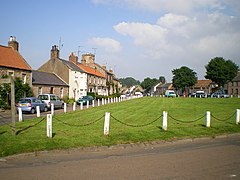Norham
| Norham | |
|---|---|
 Norham Village Green | |
Location within Northumberland | |
| Population | 579 (2011 census)[1] |
| OS grid reference | NT900471 |
| Civil parish |
|
| Unitary authority | |
| Ceremonial county | |
| Region | |
| Country | England |
| Sovereign state | United Kingdom |
| Post town | BERWICK-UPON-TWEED |
| Postcode district | TD15 |
| Dialling code | 01289 |
| Police | Northumbria |
| Fire | Northumberland |
| Ambulance | North East |
| UK Parliament | |
Norham (⫽ˈnɒrəm⫽ NORR-əm) is a village and civil parish in Northumberland, England, on the south side of the River Tweed where it is the border with Scotland.
History
It's ancient name was Ubbanford. Ecgred of Lindisfarne (d.845) replaced a wooden church with one of stone, translated the relics of St. Ceolwulf here.[2]
It is the site of the 12th-century Norham Castle, and was for many years the centre for the Norhamshire exclave of County Durham. It was transferred to Northumberland in 1844.
It was on the Tweed here that Edward I of England met the Scots nobility in 1292 to decide on the future king of Scotland.
Sir Walter Scott gained fame as a poet, particularly with Marmion set around the Battle of Flodden in 1513. It begins:
- Day set on Norham's castled steep,
- And Tweed's fair river, broad and deep,
- And Cheviot's mountains lone:
- The battled towers, the donjon keep,
- The loophole grates where captives weep,
- The flanking walls that round it sweep,
- In yellow lustre shone.
The 19th-century Ladykirk and Norham Bridge is a late stone road bridge that connects the village with Ladykirk in the Scottish Borders.
J. M. W. Turner always tipped his hat to Norham Castle, as it was the place which brought him fame as an artist. The picture of the castle which hangs in Tate Britain, luminously near-abstract, is one of the great treasures of the collection.
Norham railway station, built 1851, closed in 1965 and was turned into a museum by its final station master, Peter Short. In 2013 it was up for sale at an asking price of £420,000.[3]
Governance
An electoral ward in the name of Norham and Islandshires exists. This ward stretches south east to just short of Bamburgh and has a total population taken at the 2011 Census of 4,438.[4]
See also
References
- ^ "Parish population 2011". Retrieved 30 June 2015.
- ^ Hodges, Charles Clement. "The Pre-Conquest Churches of Northumbria", The Reliquary, April 1893, p. 84
- ^ The Daily Telegraph Nov 1st 2013
- ^ "Norham and the Islandshires ward population 2011". Retrieved 30 June 2015.
External links
- GENUKI (Accessed: 20 November 2008)

